MONTHS OF TRAINING
Lincoln, Nebraska
In early March a gang of young Californios milled around a sergeant in the vast Union Station of Los Angeles. As our names were shouted out in alphabetical order, we boarded the train—the first of many roll calls and troop trains in the years ahead. We wore old clothes, suitable for the sunshine and warmth of southern California and OK for a dusty train. We would discard them as soon as the army issued our uniforms. But, as it turned out, even in March 1943 the army was not ready for the influx of enlistees. No uniforms were in stock. Our threadbare slacks, thin shirts, and light jackets were scant protection against the gray, windy, cold winter of Nebraska. For weeks, we drilled in freezing cold and snowstorms in our old clothes insulated with newspapers and with our heads swathed in towels. We were a ridiculous parody of a refugee column. But we learned a useful bit of wisdom: the Army is not always right but it's always the Army.
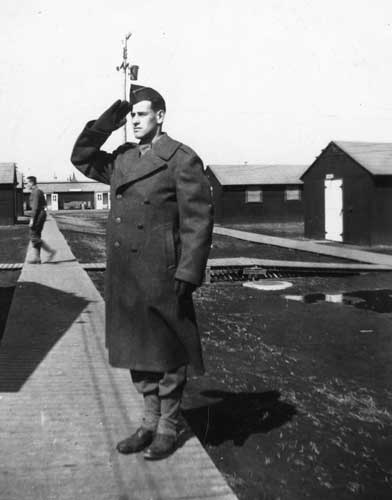 Dressed warmly (at last!), I'm showing my proficiency at saluting. We were such eager recruits that we actually practiced saluting! The wind off the Great Plains is blowing back my heavy overcoat. The Lincoln base was truly basic. It was a long way to a green lawn. March 1943.
Dressed warmly (at last!), I'm showing my proficiency at saluting. We were such eager recruits that we actually practiced saluting! The wind off the Great Plains is blowing back my heavy overcoat. The Lincoln base was truly basic. It was a long way to a green lawn. March 1943.
Eventually we were issued uniforms and began to feel more like soldiers. We adapted to barracks life. We marched. We did calisthenics in full uniform encumbered with great coats and gas masks. We were cussed by corporals and sergeants and lectured by lieutenants.
Ordered to sing as we marched, we hollered into the freezing winds off the Great Plains:
Recruits probably sang this mutation of a World War I song in whatever state they found themselves. The verse slandered Nebraskans, who could not tie the bag of Aeolus.
Lincoln, the capital of Nebraska, seemed to me to be a fine city. Citizens of Lincoln often went out of their way to welcome young men in uniform. We especially appreciated the extra large portions served us in restaurants. At the Lincoln base the army cooks may also have been new recruits. The barley soup they often dished out looked and tasted like dishwater.
From pits at a nearby National Guard range we fired old British Enfield rifles, antiques from World War I. Each of us also had a turn shooting a hand-held, rapid-firing Tommy gun, made famous by "G-men" of the F.B.I. What did such guns have to do with aviation training? Not much, but we enjoyed the noise and action.
In this period of training I took up smoking cigarettes—partly as defense against boredom (lots of hurry-up-and-wait), and partly as a defense against casual duties. The non-smoking private was "doing nothing" and was more likely to be picked by non-coms for the chores of the moment.
Bozeman, Montana
At the end of March, after only a month of basic training in windswept Nebraska, several hundred of us boarded a train to Montana. We exchanged the cold, tar-paper barracks of Lincoln for the comfortable brick dormitories of Montana State College in Bozeman. The Army had contracted with the college to house, feed, and instruct pre-cadets in basic sciences. Military subjects were taught by Army instructors. Best of all, we flew! Local pilots gave us a few hours of handling light planes. The curriculum included much marching and repeated inspections to inculcate discipline. The chief punishment was to suspend passes—a severe punishment, for Bozeman was a fun place!
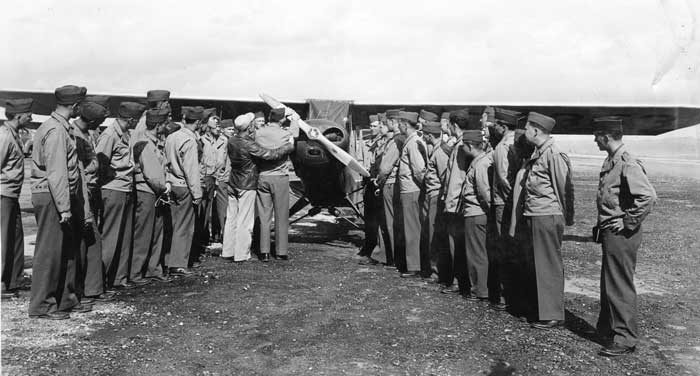
Above: Pulling the prop to prime the engine.
Below: First words from Instructor Wise to A/S Van Ide in a Porterfield Monoplane.
We had 10 hours of flying light planes, but did not solo.
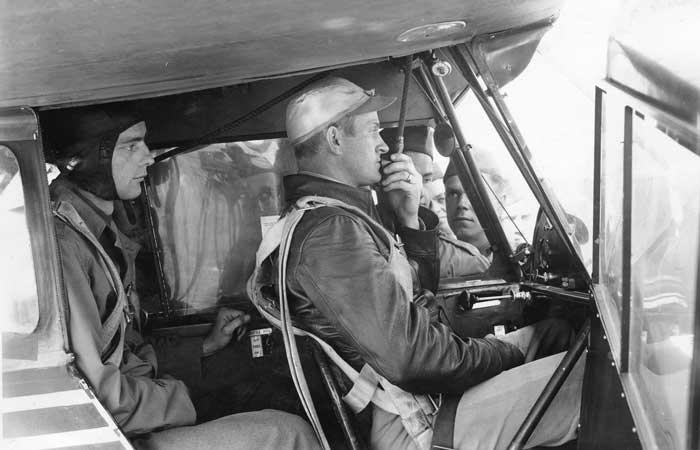
Overnight we were promoted from Buck Privates to American Heroes. All the young men of Montana were elsewhere in the armed forces (probably training in California). We students were the only men in uniform to admire and were welcomed everywhere. Restaurants served us enormous steaks. In bars no one questioned our age. (I learned to never, never again drink gin fizzes.) Weekend picnics and recreation with the Montana women enlivened the month of April. A grand picnic in the country planned for Easter afternoon was cancelled by a thick snowfall, but we partied indoors.
Indeed, life at Montana State was like living in a fraternity house. We were a high-spirited group of college students and at times found it hard to be serious at soldiering. Thus, once as Squadron E marched between classes, our bored student leader instead of continuing the cadence "Hup Tup Tree Foah", yelled the command: "CHARGE!". We broke ranks and ran, whooping like Comanches, to the top of the hill. Just over the brow stood an amazed Tactical Officer Lieutenant Brown. Let's say: he was not pleased. We never charged again...
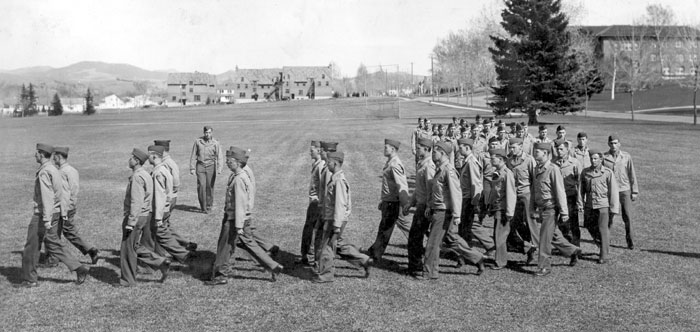
Squadron E, Flight 2, drilling; Bozeman; April 1943
My objection to the training program at Montana State was that it was so short. Although some students stayed for several months, Squadron E shipped out after only a few weeks.
The long train ride through Montana, Idaho, Washington, Oregon, and down through northern and central California revealed a part of our country unknown to me. Especially impressive were the lushness of western Washington and Oregon and the isolated splendor of Mount Shasta.
Santa Ana, California
In mid-May we detrained in Santa Ana, California about 30 miles southwest of central Los Angeles. Here we were officially recognized as Aviation Cadets. We traded in our buck private uniforms for cadet styles. The differences were merely in the insignia and the type of hat. Although our pay remained the same, our self-regard was increased.
Soon after marching in to Santa Ana we had to pass rigorous physical examinations to qualify for flying duty. Doctors separated out men who had breezed through earlier checks. Each of us also had to maintain his composure while being interviewed by a psychiatrist, a type of doctor few of us had ever met before.
Santa Ana was a classification center whose purpose was to steer us toward the aviation speciality to which we were best suited. Consequently, we went through a long series of physical and mental tests. Among those that eliminated some aspirants were a test of depth perception and a test of ambidexterity. For proving your ability to perceive depth you had to line up two vertical pencil-like sticks far down a long narrow box by pulling on attached cords. If you couldn't do that, you were not to be trusted to land Uncle Sam's airplanes. Potential bombardiers had to demonstrate skill in centering an index of a simple but tricky device that was controlled by handles on clockwise and counter-clockwise rotating disks. The device mimicked requirements of the Norden bombsight used on heavy bombers.
I was pleased that the trials of classification put me on track to navigation school. The aptitude rankings (from 1 to a high of 9) were navigator-9, pilot-8, and bombardier-8. The tests must have had some validity. When I took virtually the same tests nearly two years later my numbers were identical.
Over us, Navy gull-winged F-4U "Corsairs" and Army twin-boomed P-38 "Lightnings" criss-crossed the skies of Santa Ana in mock dogfights. On the earth of Santa Ana, drills, parades, lectures, and casual duties kept us busy between tests. As with other cadet squads, we took our turn at KP, "kitchen police". I learned the hardest job in the mess hall was in the gang waiting on tables, scurrying back and forth with heavy loads of dishes. The easiest proved to be one of the pair assigned to the running of the "China Clipper", the steaming-hot dishwasher. The machine did the work while we "pilots", hidden by the clouds of steam, sampled some of the better parts of the day's menu.
A mild case of flu excused me from a few days of KP and gave me my only experience with army hospitals. One of my hospital mates was nearly paralyzed by knotted stomach muscles. Sit-ups were part of a fitness test of cadets. I'd done the recommended top count of 114, but my suffering ward-mate had done a record 1,000!
A few weekend passes let me get back to Dad, Mother, Donald, and the comforts at 703 Boccaccio Street in Venice. Because the army grouped men alphabetically I met other Weirs in the service. A fine comrade was Harold Weir from Idaho. He accompanied me home on several weekends. He had a strong resemblance to other members of the California Weir clan. One memorable evening, along with college-classmate Norah Jones and cousin Olive Weir, we ventured into an unfamiliar sophisticated society: dinner, dancing, and floor show at Earl Carrol's Hollywood nightclub.
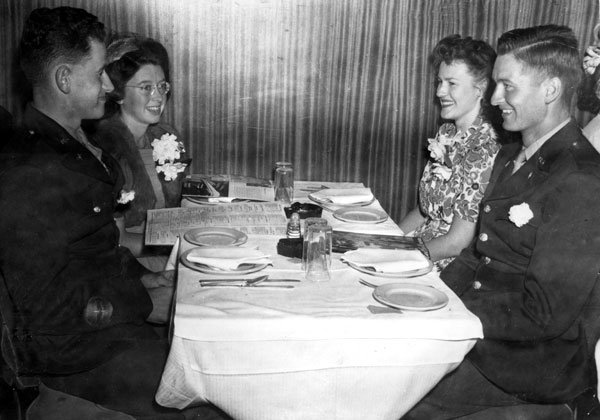
Gordon Weir, Norah Jones, Olive Weir, and Harold Weir
Ellington Field, Texas
In July cadets classified as navigators-to-be sweated through a long train ride from Santa Ana to Houston, Texas. A slow clackety-clack across deserts and dusty plains was in antique coaches blistering under a summer sun. The stiff wooden seats, many cracked, were thinly covered with frayed velvet plush. Battered lantern fixtures swayed and clanked overhead. Windows were jammed open. The steam engine pulling us was burning soft coal and cast soot and cinders into our car. When our squad of bedraggled cadets formed up outside Ellington Field, we were commanded to sing as we marched. So, we marched in through the gate belting out words to the tune of the Battle Hymn of the Republic:
When the war is over, we will all enlist again.
When the war is over, we will all enlist again.
When the war is over, we will all enlist again.
We will, LIKE HELL! we will!!!
Lucky for us, the sergeant-in-charge had a sense of humor. He'd probably sung the old soldier's verse himself.
Ellington was a pre-flight school. Our officers, however, placed more emphasis on making us soldiers than making us aviators. The morning after our arrival we were set to work in the steaming heat of summertime in coastal Texas. We "policed" (army jargon for "cleaned up") the base. A hurricane had roughed up the area days earlier and scattered debris everywhere.
Our classroom subjects were similar to those touched on in previous schooling: military discipline, customs, and sanitation, as well as a bit of meteorology and aircraft identification. Every day we were up with the sun for reveille. The morning was filled with group calisthenics followed by marching drill. Were they preparing us for the infantry? After classes came long cross-country runs. After retreat parade our evenings were more for recuperation than recreation.
I was chosen as Supply Officer for our squadron, a post with few duties and few perks. I wore a different style of hat and slept in quarters with only three other bunkmates instead of the larger, noisier barracks room. We all suffered equally from the oppressive Houston heat and humidity. None of us had yet been up in an army plane, but as the light from the airfield beacon sweeping the sky flashed at intervals into our room, we felt were truly in the Air Force.
Hondo, Texas
In October 1943, Group 21N of Ellington Field became Class 44-2 at Hondo AFB, Texas. Hondo was deep in the heart of the Lone Star State, 50 miles out on the plains from San Antonio, the nearest city. Living in this dusty hamlet, you'd be certain that Columbus was wrong. The Earth is really flat.
Letter I wrote home on my 21st birthday, October 9th, 1943
Few were the distractions in Hondo. Here we concentrated on the serious business of learning aerial navigation. Instruction continued in military niceties and necessities, and also in the complexities of weather and recognizing planes and ships of friends and foes. We were initiated into basics of radio communication. Each of us had to pass a Morse Code test of sending and receiving dots and dashes at the rate of six words a minute. For this skill I lacked talent, and passed only on the third try. And of course, marching drills and army-style "physical education" filled up our day.
I wrote home on October 17th, 1943:
".... Life has already fallen into the army routine. .... We get an hour more of delicious sleep here than we did at Ellington, rising at six for reveille. We shave, shower, and eat by seven, clean up our room for morning inspection, and march off to class at seven twenty. We sometimes stand a personal inspection upon arrival at the classroom. We sit in one classroom all morning, take a break for chow at eleven thirty, and are hard at it when one o'clock shows up. At four fifteen we knock off again for P.T. and double-time a good mile to the athletic field. We're there for an hour plus. Then we stand retreat, eat again, have an hour sometimes at our disposal, and then go back to our classroom for an hour and a half of study. At the end of this session it's nine thirty and we have to hurry to get the lights out in a half hour. .... Saturdays we go to classes only in the morning, and Sunday our only duty is a parade. ...."
Learning to be an air force navigator involved using carefully a few simple instruments along with elementary mathematics. The aerial compass differed little from shipboard models. New to me was the driftmeter, a down-looking tube. Lining up the crosshair with objects on the ground gave you a "relative wind" compared with your compass course. The navigator's only electronic aid was a radio compass, which gave a bearing on a broadcast signal. This instrument was unreliable except near a strong station. At night we sighted stars through an Air Force version of a sextant—a marvelous device that with a steady platform, clear skies, precise measurements, and reference to the correct star tables gave exact positions. We learned to use the sextant in bouncing airplanes flying through cloud-clotted skies. Plots of my star fixes often defined large areas in which I had to guess the plane's position.
At Hondo we were finally flying. The small cabin of twin-engined AT-7s carried an instructor supervising three cadets, each furnished with desk and instruments showing the plane's airspeed and altitude. Mostly we figured out where we were and where we were going by dead reckoning. That is, using the plane's instruments, the driftmeter, and our own circular slide rule and protractor/ruler, we plotted our course by estimating our ground speed and relative wind. We were graded not only on the accuracy of our plot but also on how well we recorded important data on our log of the flight.
Provided our instructor approved, we tried to check our position by identifying places on the ground. Easier said than done, because few of us had seen the world from above. Moreover, much of the Texas plain lacks distinctive features. Even the scattered towns look dully alike from several thousand feet up. At night, though, the lights of the small towns transformed the plain into a dark carpet studded with sparkling gems, a marvel to those of us who had not flown before.
Discipline was strict at this base. Inspections were frequent and demerits were imposed for trivial offenses. Ten demerits and you were confined to base on the weekend. Also for each ten demerits you had to march a punishment tour, rifle on shoulder, back-and-forth on the black tarmac in the sizzling heat of the Texas sun. Actually, we easily avoided piling up demerits if we kept ourselves and our quarters neat. But they got me. One ten-point No-No was damaging an aerial chart. I had sharp pencil in hand when our plane bounced in turbulent air. The two tiny holes in my chart taught me that I'd not be happy in the infantry.
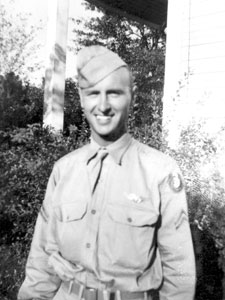
| 
|
| My roommate was John Sterrett, an amiable, soft-spoken midwesterner. We paired up on several week-end passes. Once, we took the slow train into San Antonio, a city so crowded with soldiers it seemed to be just another army camp. On another Saturday we sought out the tourist attractions of Hondo. Near the center of the town was a park, a half-acre of parched earth with a few trees struggling to provide greenery and shade. At no great distance from the park was the welcome-to-the-town sign proclaiming this was "God's Country". If this was Eden, what was Hell like? |
John was stunned and I was shocked when our instructors dismissed him with only a week to go to graduation. All of us aspiring navigators thought we had it made by then. John went on to gunnery school. We kept in touch for a while, but overseas I lost contact with John and other classmates.
Surviving air cadets of Class 44-2 assembled with a mixture of pride, joy, and relief for their last grand parade on the Hondo tarmac on February 5th, 1944. At some moment on that Saturday morning we may have been civilians, for later we received papers showing that we had been honorably discharged with the rank of privates and then commissioned as second lieutenants.
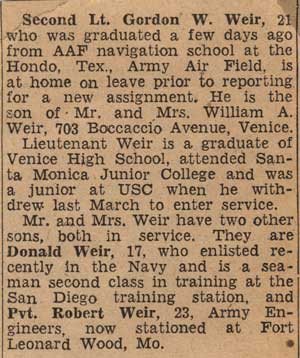 | 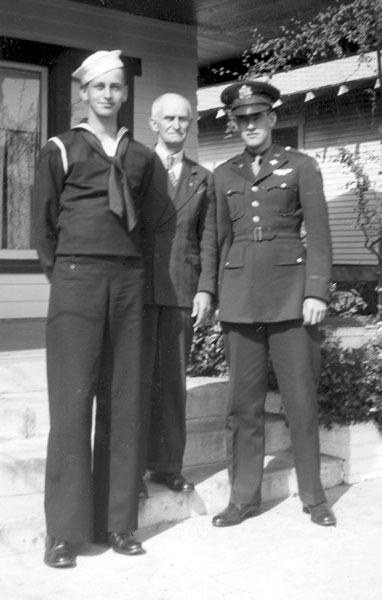 | Donald, Dad, and new lieutenant |
Home leave
Besides being given new uniforms and insignia we were granted a week of home leave before reporting to our new stations. Snapshots taken at our California home show me as a beaming lieutenant in variations of my new uniform. Those new brass bars puffed me up—an insufferable new looey. I was taken down a peg by a college professor who wondered aloud if I and my classmates weren't so overpaid as to be unable to adapt to the real world. Perhaps so, but at the time neither of us fully appreciated the real world I was heading for.
Dad was not very strong at that time. (I didn't fully appreciate what was meant by "heart trouble" till forty-plus years later.) Nevertheless, he was doing the chores necessary to keep the household running. This, because Mother, to help with the war effort, had begun work building planes at Douglas Aircraft.
Luckily, during my week in California, brother Donald in his seaman's uniform came home on a pass from his training station near San Diego. We were to be separated during the next two years by nearly half the globe as I flew towards Europe and he sailed to the far Pacific.
Biggs Field, Texas
The navigators of class 44-2 were dispersed to replacement and combat-crew training centers. In mid-February I reported to Biggs Field, a training center for heavy bombardment crews. The field was near El Paso in westernmost Texas. In the distance beyond the long runway rose a barren, cliff-faced mountain. Large blotches on the rocks were said to be stains from crashed bombers - - something to think about as a neophyte prepared himself for a flight in a four-engined plane.
My first venture into the skies from Biggs was marred by an episode of pre-flight terror. Not long after arriving, a cadre officer rousted me from sleep and ordered me to go at once to the flight line and board bomber #337. The numbers were to be found on the nose and tail of the plane. I dressed quickly, grabbed my briefcase, and hurried out in the dark. The engines of a dozen of more B-24 "Liberators" were thundering on the line. The tailplane numbers could not be seen in the darkness. I had to make my uncertain way from plane to plane around flashing propellers of roaring engines to scan the small numbers painted near each nose. I finally climbed up through the bomb bay of the right plane. My first ride in a B-24 was over the Texas plains I'd seen from Hondo a month earlier. To my annoyance, however, I was never credited with the flying time I earned that day.
I was not assigned permanently to a crew at Biggs. The field had an oversupply of new lieutenants with my MOS 1034 [Military Occupational Specialty: Navigator]. We did little flying and much waiting around. Each of us spent boring hours uncomfortably boxed in a Link Navitrainer, a jiggling mechanical apparatus furnished with instruments that tested one's ability to do dead reckoning. After two weeks with only this ersatz flying, we began to wonder if our training days were over. Were we to be shipped overseas individually to replace navigators who were disabled or who had finished their tours?
I and my colleagues were anxious to go. By now almost two years had passed since I first went to enlist. Some of my friends had been fighting since 1942. We all wanted to be part of the winning of the war. [However, I was surely fortunate to miss the difficult battles between a slowly growing Eighth Air Force and a strong Luftwaffe in 1943. The tenor of those aerial conflicts is well described in the book The Fall of Fortresses by E. Bendiner, a navigator who landed in England just a year before I did.] Finally, late one February night, I was rousted from bed for more hours jinking on the Link Navitrainer. That done, I was handed orders to report to McCook, Nebraska.
McCook, Nebraska
How I was chosen to be sent north from Texas to Nebraska will never be known to me, but I regarded the transfer as a stroke of good fortune. Although I had been ready, even anxious, to go overseas as an individual or with a replacement crew, going with a crew of a group was much better. A crew training in a newly formed group had the opportunity to practice their military specialties together and with other crews.
The 493rd Heavy Bombardment Group
In McCook I became a member of the 493rd Heavy Bombardment Group, commanded by Lieutenant Colonel Elbert Helton. The Group had been activated only a few months earlier. Although it included experienced men in the cadre, most of the personnel were freshmen lieutenants and sergeants. The Group was organized as an operations squadron—the 860th, and three flying squadrons—the 861st, the 862nd, and the 863rd, equipped with four-motored B-24s. I was assigned to the 861st Squadron under the command of Major Samuel Hale and to the crew of First Lieutenant Ellis M. Woodward.
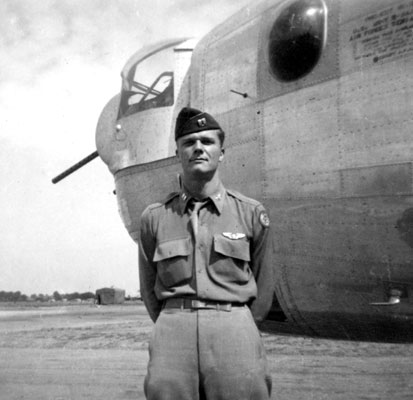 First Lieutenant Ellis M. Woodward, "Woody"
First Lieutenant Ellis M. Woodward, "Woody"
Woodward's Crew
"Woody" or "E.M.", as we came to call our pilot, was a more experienced flyer and had more military training than most others his age in the group. He was a square-jawed Southerner, educated at a military academy in New Orleans. He'd gone on to two years of Naval R.O.T.C. at Tulane University and then enlisted in the Army Air Force in August of 1941. A year later he was a commissioned pilot. Before becoming a charter member of the newly formed 493rd in late 1943, Woody had many hours of multi-engined flying time in such aircraft as the obsolescent B-18, the speedy B-25, and the big B-24. He was only two years older than myself, but that seemed a lot when I'd just turned 21.
Moreover, E.M.'s military background and time in service placed him at the head of the lieutenants in our group. He was an excellent pilot and an excellent commander. The pilot of a heavy bomber had more to do than just fly a four-motored behemoth. He had to lead a crew of nine others. Woody insisted on discipline aloft. We avoided use of familiar names over the intercom. It was "navigator to pilot...", or "Lt. Weir to Lt. Woodward...", and similarly for calling others in the crew.
At first, I was unsure how long I would be linked to Woody, because his crew already included an experienced navigator, First Lieutenant Frank Littleton from Baltimore, Maryland. Frank and Woody were old friends, who had served together earlier in a squadron hunting submarines off the New England coast. Frank was the 861st Squadron navigator, and though he often flew with us, he had larger responsibilities. He was of great help to me as a coach and in explaining to Woody inherent difficulties of navigating in big bomber.
 William ("Bill") Rawson
William ("Bill") Rawson
Co-pilot Bill Rawson, from the D.C. area, was at nineteen years the youngest officer of the crew. He aided Woody in the many details of flying the big airplane. At times Bill piloted the plane himself, making our B-24 part of a perfect V formation. The "Liberator" was a heavy-handed airplane and required of the pilots physical stamina as well as skill and concentration.
Woody's first bombardier and I were together only on a single flight. As we came down through the wintry sky, clogged sinuses pained him. He was soon replaced by Flight Officer Marvin ("Mike") Wright from Grand Rapids, Michigan. Mike proved himself excellent in his specialty. We shared the nose compartment of the bomber and became close friends.
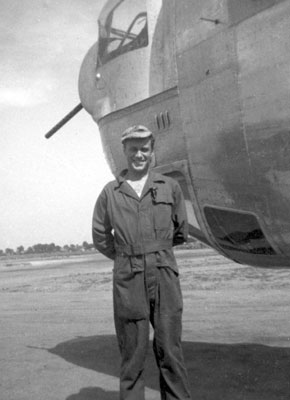
Technical Sergeant Joseph Vales
| 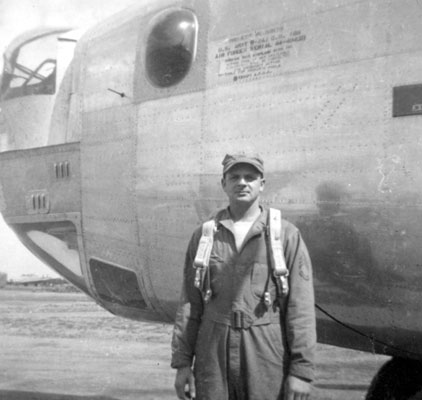
Technical Sergeant Joseph Sutton
|

Staff Sergeant George Spinney
| 
Staff Sergeant Blair Archer
|
Behind the cockpit, watching the engine gauges, stood flight engineer Technical Sergeant Joseph Vales, the crew engineer. He assisted the pilots as needed. In combat he was to man the top turret that protected us from attacks from above. His equally important duty was to watch over the workings of the plane and to oversee needed repairs or adjustments. Woody described Vales as a "tremendously gifted airplane mechanic", high praise our engineer merited from all of us.
Technical Sergeant Seth Smith was our radio operator on the B-24 and also fired a waist gun. Technical Sergeant Joseph Sutton handled the nose turret in the B-24. Staff Sergeant George Spinney manned the other waist gun. Staff Sergeant George Kenawell, our youngest non-com, defended our most vulnerable sector with the twin guns in the tail turret. Staff Sergeant Blair Archer occupied the most difficult gun position, the ball turret in the belly of the plane. This turret rotated horizontally the full circle of 360 degrees and vertically through 90 degrees. Archer was a small man, but he had to curl up in a fetal position in the metal carapace of this lethal weapon. Once inside the cold spheroid, he was alone, out of sight of the crew, connected to us only by the thin wire of the intercom. At the end of a flight he needed help to get out of his cramped position.
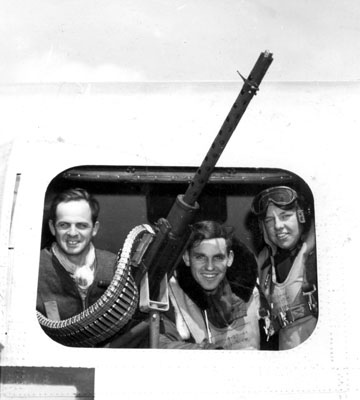
Sutton, Kenawell, and Rawson at the left waist gun.
A projection on the left deflects in flight the constant,
cold 150-mile wind blowing over the exposed gunner.
Training flights
Although Woodward had many hours flying the B-24, the plane was new to most of us. Within the 67-foot-long fuselage we each rehearsed our military specialties along with the rest of the crew. For the pilots, this meant many day and night takeoffs and landings and flying in large and small formations. Mike Wright "bombed" with a camera an oil refinery in Cheyenne, Wyoming (a type of target we were to know well before the year's end). Mike also dropped some hundred pounders onto bull's-eyes marked on empty plains. Woody pushed the plane down to a few hundred feet over a gunnery range to give our defenders practice firing their weapons. This exercise was exciting but I didn't appreciate the danger until later. The 493rd suffered its first loss when a plane with a crew of ten smashed into the ground on this range on the last day of practice.
As for me, all I had to do was to keep track of where we had been, to know where we were and how to get where we were going, and to tell when we were going to get there. Well, I never was lost, but I confess to moments of uncertainty.
No description of our sojourn in McCook should omit a comment on the climate. Our last home-away-from-home before England was on the cold, wind-swept high plains of the West, where winter and spring weather range from capricious to treacherous. Pity the doomed meteorologist who had to predict what might be sweeping down from the Colorado Rockies beyond the horizon. One morning the whole Group was briefed for a practice formation flight. Last to speak was our weatherman, who promised us a day of sunshine and light winds. We were dismissed to our planes. The doors were opened. Snow blasted into the room from an April blizzard. Back to the barracks we trudged. Perhaps our months in McCook toughened us for the cold, drizzly winter that we were to know in England.
My great stateside test and also Mike's came on the day in April when Lt. Colonel Helton named our crew to lead the whole group on a practice mission. Staff mapped out a long zigzagging flight down across Texas to a target in Oklahoma. Helton would criticize the group's performance from the co-pilot's seat in our plane.
Not long after takeoff we were above a layer of clouds that masked the ground. None of the turning points could be seen. I had no way to check our position except to take bearings with the radio compass on the signals of radio stations scattered over Texas. Problem was that the signals spread fanwise and the farther from the station the wider the fan. All I could do was to estimate our position within overlapping fans. With the Group commander aboard I wasn't about to confess my doubts to Woody. Instead I continued to relay compass headings and ETA's (Estimated Time of Arrival) for each dogleg and finally for the target approach.
Mike busied himself with the preparations for bombing, though neither of us knew whether Texas or Oklahoma lay below the clouds. A minute before my predicted ETA the Colonel came over the intercom, "There it is!" The clouds had suddenly parted. The target lay dead ahead. Mike had the bomb bay doors rolled up and clicked the camera from the bombsight as we passed over the bull's-eye. Few of the other planes in the flight had even rolled up the doors. The rest of the trip was uneventful. Later, I received undeserved compliments on my navigating skills. Sometimes compensating errors do compensate!
The B-24
The B-24 or "Liberator" (we seldom used the name) came in many different models, each given an appended letter. In our training days we flew B-24s D, E, G, and J. Models D, E, and G had a glassed-in nose and varied in details of armament. They were painted brown or greenish brown. Mike Wright as bombardier and I as navigator liked these obsolescent models because the glassed nose was easy to see out of as we sought to identify targets and checkpoints.
By 1944, the B-24J in its original shiny aluminum replaced the earlier versions. In this combat model our crew did most of its training at McCook. The B-24J had a bit longer nose that besides accommodating Mike and me was fronted by a powered twin-gun turret. Although this turret blocked our view, we appreciated that it might also block attacking fighters. To the left of my desk and instruments was an opening to the nosewheel compartment—a space to be avoided for we'd been warned of the danger of falling through the nosewheel doors.
Mike and I were separated from the pilots and their racks of instruments and controls by a partial wall, though a crawl space led up to the flight deck. Besides the pilots and engineer, the radioman attended his equipment here. Overhead was the top gun turret. Aft of the flight deck was the immense bomb bay, almost a third of the length of the plane. A narrow girder was the path across the bay to the rear of the plane. As you carefully made your way aft, you wondered about the sturdiness of the thin aluminum doors. The rear of the plane contained the waist swivel guns, the belly turret, and another automatic gun turret beyond the twin rudders at the tail.
Some supercilious airmen, mostly B-17ers, disdained our B-24s. The side view of a 24 was of a chunky-nosed, slab-sided boxcar. However, the "Liberator" was graced with a long, narrow wing. Seen from below or above, especially when flying with others in a V-formation, the B-24 was a handsome bird. And it was whispered about that a superiority of the 24 was that its wheel wells, unlike those of a 17, could conceal cases of whisky.
At the end of April 1944 we received orders to take our planes to England. All of us—aircrew, staff, and ground personnel—had practiced our duties together and built up our confidence in ourselves and in each other to give the 493rd an esprit de corps. We were ready to go, though we were to find out that we had much more to learn.
Part II: Combat Europe
To the European Theatre of Operations
Back to Navigating Through World War II Home Page
 Dressed warmly (at last!), I'm showing my proficiency at saluting. We were such eager recruits that we actually practiced saluting! The wind off the Great Plains is blowing back my heavy overcoat. The Lincoln base was truly basic. It was a long way to a green lawn. March 1943.
Dressed warmly (at last!), I'm showing my proficiency at saluting. We were such eager recruits that we actually practiced saluting! The wind off the Great Plains is blowing back my heavy overcoat. The Lincoln base was truly basic. It was a long way to a green lawn. March 1943.







 First Lieutenant Ellis M. Woodward, "Woody"
First Lieutenant Ellis M. Woodward, "Woody"  William ("Bill") Rawson
William ("Bill") Rawson 



